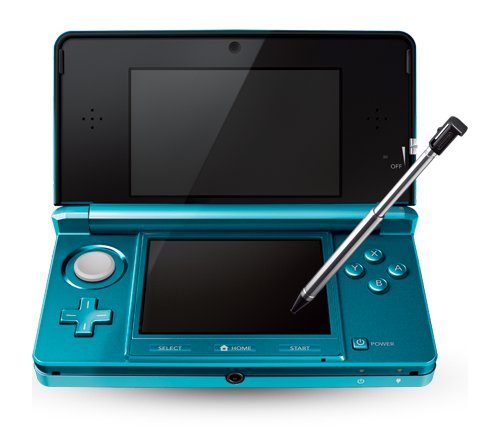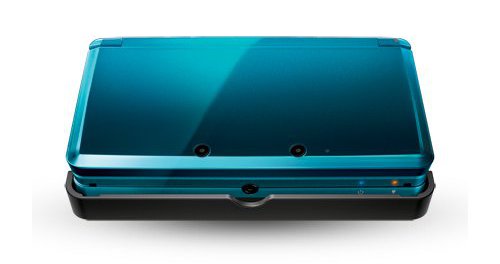There is nothing quite like a good, comfy war. It is what makes the world an interesting place, and there’s nothing better than a war between two competing formats. Think of all the great format wars past: VHS vs Betamax; CD vs vinyl; 8-track vs cassette; Genesis vs Super Nintendo; Playstation 2 vs Xbox vs Gamecube; HD-DVD vs Blu-Ray. We’re all naturally fascinated by battles between giants. We’ve seen this battle play out over and over, placing our bets to try and figure out in advance who the winner is going to be. Sometimes there is no clear winner. Either way, the fun is in the speculating, so we’ll dive right into the fun of the next great war of portable gaming: Nintendo 3DS vs the Sony Next Generation Portable (which currently has no official name). I swear I’ll try to keep this as civil—and unbiased—as possible. The fisticuffs follow after the jump.
In the red corner: Nintendo 3DS!
What is it?
In a nutshell, the 3DS is the up-and-coming successor to Nintendo’s incredibly successful Nintendo DS. It has an impressive features list that includes the standard resistive touch screen, glasses-free 3D display on the top screen, three VGA resolution cameras (two on the outside, one inside), Wi-Fi (only 802.11b and g, no 802.11n support), accelerometer, gyroscope, an analog nub, and the standard D-pad, shoulder buttons, and ABXY control buttons. Software-wise, the 3DS supports Miis, 3D video support, content sharing, backward compatibility with DS and DSi software, augmented reality, and a cash-based eShop for virtual console games (as opposed to the points-based shop that the Wii and DSi use).
Where did it come from?
The DSi, the last handheld released by Nintendo, was essentially a rehash of the DS Lite, which itself was a rehash of the original, now discontinued, DS. I don’t think Nintendo really saw the DSi as the successor to the DS Lite. Yes, it had faster processors, cameras, better Wi-Fi support, and support for digital purchases, but by and large, it was still the same old beloved DS Lite.
The 3DS, on the other hand, is a completely new machine. Instead of the D-pad alone, the console now features an analog nub, similar to the PSP’s control nub. There’s the new 3D upper screen. New core and graphics processors. Motion control accelerometers and gyroscopes. It is more than just “an evolved DSi”.
Why?
“Why” is an awfully good question, but I’m willing to make the uneducated guess that Nintendo saw several looming threats in the handheld market. Primary amongst those threats was the surprising handheld contender: iOS devices, the current generation of which consists of the iPhone 4, the iPad, and the iPod Touch 4th generation. Secondary threats included the imminent PSP2 from Sony, which had been rumored in the gaming marketplace long before Sony announced the handheld. Tertiary threats come from Android-enabled devices and similar smartphones and tablets. The portable market has become more crowded than the second, third, and fourth circles of hell put together. All of these devices have a lot in common: multi-touch screens; Wi-Fi; app repositories (in the form of “stores” and “shops”). Nintendo’s answer to all of this is to offer something different, something completely audacious, and in its eyes, the next big thing: 3D.
So what’s the strategy?
What insight can we gain about Nintendo’s strategy from analyzing the range of features of services that the 3DS offers?
Nintendo seems keen to maintain backward compatibility in the DS line of handheld consoles. Yes, they may have dropped backward compatibility for the Game Boy Advanced (as of the DSi), but it is a great way to ensure that the amazing DS software library is available for use with the 3DS. The obvious big pull for the 3DS is the addition of the 3D screen. The 3D screen is supported by two cameras on the front of the 3DS that allows you to take 3D pictures and movies, or allow for 3D augmented reality. My biggest fear with the screen is that many video game companies will use it as a shovelware gimmick instead of putting it to clever use. Still, the use of a 3D screen without the need for glasses is an amazing feat.
What I find odd is that in all this, Nintendo has not explicitly claimed interactivity between the Wii and 3DS. This would be a great pulling feature for the many millions who already own Wiis. The DS and DSi support for Wii games is sparse (Guitar Hero and Geometry Wars comes immediately to mind, but no others), but it was incredible fun where it occurred. Since the 3DS has motion control, it is not inconceivable that it could be used as a Wii controller. Maybe some developers will put this to good use, but I don’t see this happening, which is a great pity.
Will it work?
“First to market” has always been a great advantage, but not necessarily the only advantage. A veritable slush of factors must be taken into account to try and determine what’s going to happen: price, positioning, features, software library, 3rd-party support, hype, visibility, desirability, the list goes on and on, and is more the domain of professional market analysts. One cannot deny that the 3D feature is a major pull, possibly its biggest pull. The set price of US$ 250 (ZAR 1,820, but expect that to almost double by the time it hits our shores) pushes it way past the current price of the DSi XL at US$ 180 (ZAR 1,310, but retailing at an effective ZAR 2,000 to ZAR 2,500), and might be a turn-off for initial consumers. I do not doubt that it will sell out in its initial run. People will pay for high desirability, and from the looks of the expected library of 3DS games (including new 3D Mario, Kid Icarus, Kingdom Hearts, Zelda, Bomberman, Nintendogs, Star Fox, and Resident Evil titles), it is going to be a incredibly desirable.
Next page: The Sony NGP…






5 replies on “Opinion: Nintendo 3DS vs Sony NGP—FIGHT!”
Great piece. Personally i will in all likelyhood get both – sucker for new gaming tech – but the NGP looks the more impressive of the two. Nintendo’s announced launch titles are also seriously lacking imo. Basically a combination of ports and shovelware. Nintendogs + Cats will sell by the bucketloads of course, but there are no launch titles that scream “you need to own and play me”. Pity something like Kid Icarus or Steel Diver couldn’t be included for its launch.
The big problem with both platforms, I feel, is the rehashing and porting happening on both sides. I suspect it’s a stopgap while they get the system-specific games under control, but still. I think we’re only likely to see the best games for the systems at least a year after launch.
@TD, I think the reason for the rehashing is ultimately to attract customers. If I went into a shop, and this new console is staring me down and I look at a list of games and I know none of the titles, it will put me off. But seeing Uncharted, Killzone, Resistance that pretty much guarantees a purchase from my side. Also these are not ports, they are entirely new games, albeit from old franchises.
Both definitely have a pull, but the fact that Sony listened to what we wanted and stuck 2 sticks, an uber AMOLED display, 2 cameras and close to PS3 quality games really grabbed me.
I was looking forward to the 3DS, but as time went on Nintendo shot themselves in the foot by announcing that the device will cost $250, the games may be region locked and also 3D on a handheld is kinda iffy.
You make a good point about familiarity Riezo and the part that it may play in purchases. If someone owns a Nintendo DS and has had good experiences with it, would they not be more drawn to the new 3DS as opposed to looking at the NGP and vice versa?
[…] I said exactly this thing about the PS3/Vita combination a few months ago when the Vita (then called the NGP) was first announced. Coupled with the news that the Nintendo DS is still outselling the Nintendo 3DS by a ridiculous factor of 2 to 1, you’re lead inevitably to this question: is it time for Nintendo to leave the major console hardware market and concentrate on handhelds and software alone? Is it time for Nintendo to pull a Sega? […]